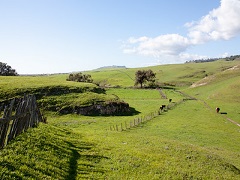The Bureau of Land Management releases proposed plan for Cotoni-Coast Dairies that includes wildland fire prevention
Organization:
BLM Office:
Media Contact:
 MARINA, Calif. – The Bureau of Land Management Central Coast Field Office has released its Cotoni-Coast Dairies proposed Resource Management Plan Amendment and Environmental Assessment for the California Coastal National Monument that will provide management direction for Cotoni-Coast Dairies public lands in Santa Cruz County. Today’s announcement begins a 30-day protest period and 60-day Governor’s consistency review.
MARINA, Calif. – The Bureau of Land Management Central Coast Field Office has released its Cotoni-Coast Dairies proposed Resource Management Plan Amendment and Environmental Assessment for the California Coastal National Monument that will provide management direction for Cotoni-Coast Dairies public lands in Santa Cruz County. Today’s announcement begins a 30-day protest period and 60-day Governor’s consistency review.
Cotoni-Coast Dairies was donated to the BLM in 2014 and encompasses nearly 6,000 acres along Santa Cruz County’s North Coast. Access to the property is currently limited to guided tours. Cotoni-Coast Dairies extends along the Pacific Coast Highway near Davenport. This area is marked by six forested perennial streams that flow from the Santa Cruz Mountains into the Pacific Ocean and between these riparian drainages are broad marine terraces. These public lands support a wide variety of habitats and wildlife, including coho salmon, steelhead trout, California red-legged frogs, mule deer and mountain lions.
The CZU Lightning Complex Fire recently tore through the North Coast burning more than 86,000 acres in Santa Cruz and San Mateo counties, including roughly 1,000 acres on the Cotoni-Coast Dairies.
“The BLM sympathizes with our neighboring communities as they rebuild from the widespread damage caused by the CZU Lightning Complex Fire,” said Central Coast Field Manager Ben Blom. “Public access to outdoor recreation is integral to the way of life in Santa Cruz County, and enjoying the natural scenic beauty of Cotoni-Coast Dairies can help brighten our spirits and strengthen our bodies, aiding in the North Coast’s recovery from these devastating wildland fires.”
In addition to public access and recreation, the preferred alternative includes a commitment to vegetation management that will help reduce the available fuels that can feed wildland fires. The proposed plan authorizes livestock grazing on more than 2,000 acres of public lands, and the use of prescribed controlled burns and mechanical treatments that will prevent encroachment of woody vegetation into the wildland-urban interface.
The plan also includes three public access points, with two year-round and one seasonal parking area, and pedestrian/bicycle connections to San Vicente Redwoods and the North Coast Rail Trail. Nearly 27 miles of new trails would provide day-use recreation opportunities for hikers, bicyclists, horseback riders and dog walkers. All forms of recreation on the property will provide opportunities for exercise, challenging trail features, world-class vistas, nature viewing, bird watching and photography. Approximately half of the area would be set aside as core habitat for fish and wildlife, with limited recreation access.
This effort advances the Administration’s goals identified in Secretarial Order 3366, “Increasing Recreation Opportunities on Lands and Waters Managed by the U.S. Department of the Interior” and Secretarial Order 3347, “Conservation Stewardship and Outdoor Recreation.”
Information about this planning effort, along with the agency preferred alternative and instructions for filing a protest is available online at: https://go.usa.gov/xEJAw. Formal public protests pertaining to the analysis presented in the proposed RMPA/EA will be accepted for 30 calendar days, until Oct. 26, from those who have standing. Pending the outcome of the protest period and Governor’s consistency review, the BLM will issue a decision record.
Before including addresses, phone numbers, email addresses or other personal identifying information in a protest, protesters should be aware that the entire protest, including personal identifying information, could be made publicly available at any time. While the public may ask the BLM to withhold personal identifying information from public review, the BLM cannot guarantee that it will be able to do so.
The BLM manages about 245 million acres of public land located primarily in 12 western states, including Alaska, on behalf of the American people. The BLM also administers 700 million acres of sub-surface mineral estate throughout the nation. Our mission is to sustain the health, diversity, and productivity of America’s public lands for the use and enjoyment of present and future generations.
